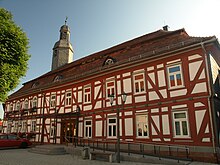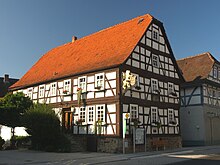Soft off
Weichaus was the former suburb of the Ziegenhain water fortress , east of the Schwalm , then became part of the town of Ziegenhain and is therefore now part of a district of Schwalmstadt in the Schwalm-Eder district in northern Hesse .
location
Weichaus adjoins the Ziegenhain Fortress district to the east and extends along Wiederholdstrasse and Kasseler Strasse (both sections of Bundesstrasse 254 ). The street "Weichaus" lies on the northern edge of the former suburb.
history
Weichaus was first mentioned in 1585, but at that time it was already larger than Ziegenhain (79 house seats) in terms of the number of households (83 house seats) itself. The Thirty Years War brought a decline in the population of both parts of the city: in 1639 there were still 60 households in Ziegenhain and 59 in Weichaus. After that, Weichaus grew considerably stronger than Ziegenhain. In 1705 84 households were counted in Ziegenhain, but already 135 in Weichaus. In the 19th century, the old districts of Fortress and Weichau gradually grew together through further development. Only at the beginning of the 20th century began a notable expansion of the city beyond the area of the historic city and suburbs.
Until the end of the 18th century, Ziegenhain was only accessible through the Philippstor in the north. This was also the only connection to the suburb of Weichau, from which the fortress could be reached via the drawbridges and the moat.
In 1625, Weichaus was fortified with ramparts , ditches and two bulwarks. Nevertheless, the suburb was taken during the Thirty Years' War by troops of the Catholic League in the first week of October 1631. Troops of General Tilly moved from Fritzlar to Ziegenhain where they, the suburb, many farmers in the surrounding villages had fled with their cattle into the looted and pillaged . A company of Hessian horsemen lying in Weichaus was partly killed and partly taken prisoner. Half of the town fell victim to a fire set during the looting. As a result, Hessian relief troops came from the fortress Ziegenhain, chased the Tilly people out of the village, freed the captured farmers and soldiers and pounded Tilly's people, about 300 of whom are said to have died, with artillery fire throughout the night. The enemy withdrew and reached Fulda on October 6th .
Since access to the fortress city was often closed during the Thirty Years' War, a school for suburban children was set up in 1641 in the building of today's town hall. It was not closed until 1846, when the large school building (the old Carl Bantzer School) built in 1842–1846 in the avenue between the old districts of Fortress and Weichau was ready for occupancy and now took in all school children from both districts. The previous school building became the town hall of the entire city.
Coordinates: 50 ° 54 ′ 44 " N , 9 ° 14 ′ 35" E
Individual evidence
- ^ Matthaeus Lungwitz: Dreyfachen Swedish Laurel Krantzes and Triumphirender Victory Crown Third Part, Johan Grossen, Leipzig, 1633 (p. 455)
Web links
- Weichaus, Schwalm-Eder district. Historical local dictionary for Hessen. In: Landesgeschichtliches Informationssystem Hessen (LAGIS).
- View of Ziegenhain, 1646. Historical views of the town, plans and floor plans. In: Landesgeschichtliches Informationssystem Hessen (LAGIS).


